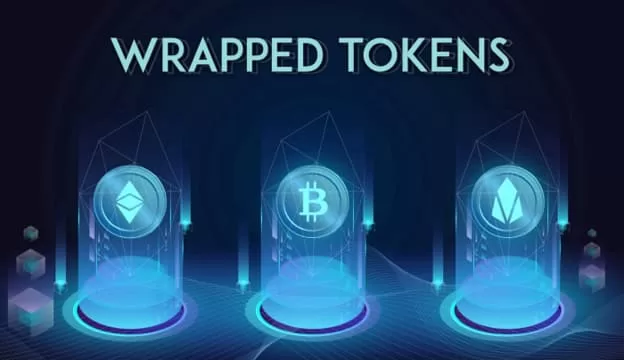In the world of cryptocurrency and blockchain technology, interoperability is a significant challenge. Currently, it’s not possible to transfer digital assets from one blockchain to another seamlessly. This means that, for example, you cannot use a cryptocurrency based on one blockchain to access decentralized applications on another blockchain. This lack of interoperability is one of the primary hurdles for decentralized finance (DeFi) as coins and tokens exist across different blockchains.
However, there is a solution to this problem – Wrapped Tokens.

Table of Contents
What are Wrapped Tokens?
Wrapped tokens are digital assets that are backed by another asset. They are created by locking up the original asset as collateral and then issuing the equivalent amount of wrapped tokens. Wrapped tokens are typically created through smart contracts on blockchain networks, which automate the process of token creation and redemption. The most popular wrapped tokens are wrapped Bitcoin (WBTC) and wrapped Ethereum (WETH), which are backed by Bitcoin and Ethereum, respectively.
How do Wrapped Tokens Work?
Wrapped tokens are tokens that represent other cryptocurrencies or assets. The process of creating a wrapped token is called “wrapping”, while the process of exchanging a wrapped token for the underlying asset is called “unwrapping”. When a token is wrapped, an equivalent amount of the underlying asset is locked in reserve, providing the token with its value.
Here’s a step-by-step guide on how wrapping a token works, using Bitcoin as an example:
- Step 1: A merchant sends Bitcoin (BTC) to a custodian who is responsible for securing the BTC reserves on the Bitcoin network.
- Step 2: The custodian adds the BTC to a reserve, which is usually held in a multi-signature wallet. The proof of this reserve is then published on-chain.
- Step 3: An equal amount of an ERC-20 compatible wrapped token, such as wrapped Bitcoin (WBTC), is then minted on a different blockchain, such as Ethereum.
- Step 4: The merchant can then use the wrapped token on the Ethereum blockchain for various purposes, such as trading or lending.
To reverse the process and unwrap the token, the merchant follows a similar process and sends the wrapped token to the custodian, who then burns the token and releases an equivalent amount of the underlying asset (in this case, BTC).
The three main actors involved in wrapping tokens are:
- Merchants: Entities that lock their underlying assets to mint new wrapped tokens or burn wrapped tokens to free up the locked assets.
- Custodians: Organizations responsible for securing the underlying asset reserves on their native blockchain network.
- Wrapped Tokens DAO: A decentralized autonomous organization (DAO) consisting of various organizations that collectively decide which custodians and merchants to add or remove from the network.
In the case of WBTC, the Wrapped Bitcoin DAO is responsible for selecting and monitoring custodians and merchants to ensure the security and transparency of the wrapped token.
Benefits of Wrapped Tokens:
- Increased Liquidity:
Wrapped tokens increase liquidity by enabling users to trade digital assets on decentralized exchanges (DEXs) that support the underlying asset. This means that users can easily trade their digital assets without having to worry about liquidity issues, as there will always be buyers and sellers for the underlying asset.
- Interoperability:
Wrapped tokens enable interoperability between different blockchain networks. For example, wrapped Bitcoin (WBTC) is a token that is backed by Bitcoin and can be used on the Ethereum blockchain. This means that users can access Ethereum-based decentralized applications (dApps) using their Bitcoin holdings, which was previously not possible.
- Accessibility:
Wrapped tokens make it easier for users to access the benefits of different blockchain networks. For example, if a user wants to participate in the Ethereum ecosystem but only holds Bitcoin, they can convert their Bitcoin into wrapped Bitcoin and then use that to interact with Ethereum-based dApps.
- Potential for Yield Generation:
Wrapped tokens can also be used to generate yield through lending or liquidity provision. For example, users can provide liquidity to Automated Market Maker (AMM) pools on decentralized exchanges and earn fees in return.
Risks and Concerns:
- Centralization:
One potential risk of wrapped tokens is the potential for centralization. Wrapped tokens are typically issued by a group of centralized entities, which may have control over the creation and redemption of the tokens. This could lead to a concentration of power in the hands of a few entities, which could have negative consequences for the decentralization of the blockchain ecosystem.
- Security:
The security of wrapped tokens depends on the security of the underlying asset and the smart contract that is responsible for creating and redeeming the tokens. If the smart contract is vulnerable to attacks or the underlying asset is hacked, then the wrapped tokens may also be at risk.
- Counterparty Risk:
Wrapped tokens also carry counterparty risk, as they are backed by another asset that is held by a third party. If the third party becomes insolvent or otherwise unable to honor their commitments, then the value of the wrapped token may be affected.
Examples of Wrapped Tokens
Wrapped Bitcoin (WBTC)
Wrapped Bitcoin (WBTC) is a token that is backed by Bitcoin and can be used on the Ethereum blockchain. WBTC is issued by a group of centralized entities, including BitGo, Kyber Network, and Ren.
WBTC brings greater liquidity to the Ethereum ecosystem including decentralized exchanges (DEXs) and financial applications.
Today, the majority of trading volume takes place on centralized exchanges with Bitcoin. WBTC changes that, bringing Bitcoin’s liquidity to DEXs and making it possible to use Bitcoin for token trades.
It standardizes Bitcoin to the ERC20 format, creating smart contracts for Bitcoin. This makes iteasier to write smart contracts that integrate Bitcoin transfers.
You can read all the details of this process on WBTC Network!
Wrapped Ethereum (WETH)
Wrapping Ether tokens involves sending ETH to a smart contract. The smart contract will generate wETH in return. Meanwhile, ETH is locked to ensure that the wETH is backed by a reserve.
Whenever wETH is exchanged back into ETH, the exchanged wETH is burned or removed from circulation. There are several ways to wrap Ether, for example, you can use platforms like Opensea, Uniswap or Metamask.
Wrapped XRP (WXRP)
XRP is a cryptocurrency that runs on the native XRP Ledger and facilitates transactions on the Ripple Network. One can purchase XRP for financing transactions, investing or exchanging crypto on Ripple. For a transaction involving the use of XRP on any other blockchain than Ripple, Wrapped XRP will be used.
Wrapping XRP increases the scope and utility of XRP to be used on multiple blockchains other than its native XRP Ledger.
Wrapped Zcash (WZEC)
Zcash is a privacy-focused cryptocurrency that uses zero-knowledge proof technology to protect the privacy of its users. Wrapped Zcash (wZEC) is a tokenized version of Zcash that can be used on Ethereum’s blockchain, allowing users to access the benefits of Zcash while still being able to
participate in the Ethereum ecosystem. This can increase liquidity and accessibility for Zcash, while also providing users with more opportunities to use the token.
Conclusion
Wrapped tokens have emerged as a solution to the lack of interoperability between different blockchain networks, enabling users to access various DeFi applications and financial products across different ecosystems. While they offer several benefits, users must also be aware of the potential risks and drawbacks associated with wrapping tokens. As the DeFi space continues to evolve and mature, it will be interesting to see how wrapped tokens continue to play a role in the ecosystem.

An experienced leader in software engineering and technology, I’ve driven value for top-tier Fortune 100 and 500 clients as the former CTO of Big Drop Inc. Overseeing a global team, we secured 34 global awards for pioneering web design using our proprietary tech. As the Co-Founder of Motion Design School, I created an innovative platform for global artists. Now, I apply my expertise to the dynamic world of blockchain, leveraging years of experience to shape decentralized technology’s future.